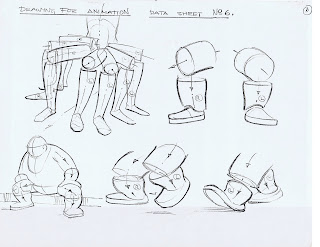While I can't state definitively why Robin Hood in particular is seen by so many as the quintessential anthropomorphic character, I can say that he is a classic case of form following function in animated character design.
The studio chose to tell the "Robin Hood" story with animals. A fox, known for being a clever, attractive, and thieving animal, was the natural choice for the title roll. But there's one obvious problem with animating a more natural fox (such as Bagheera, who was a very natural panther); he has to draw a bow.
This becomes quite a trick for a natural fox. His shoulder blades rest on his sides, not across his back, which won't allow him to comfortably rotate his elbow up to eye level while keeping his "forearm" (front leg) straight and horizontal. Comparative anatomy between dog and human skeletons shows us that this is just the beginning of a natural fox's troubles with the role:
His humerus is too short to allow him to draw the bowstring all the way back to the level of his ear, he has no opposable thumbs to allow him to grasp the bow in the first place, and his toes are likely too short to hold an arrow to the string. Plus, standing on what amounts to his tiptoes to do all of this becomes rather awkward.
Famed Warner Brother's animator Chuck Jones had a simple formula for turning the hind legs of animals into easily animated human-like feet for anthropomorphic animals:
Anything covered by the shoe became the foot, while the sock covers the ankle and calf. This is exactly how Robin Hood's hind feet were redesigned. The rest followed in much the same way; The humerus and toes made it halfway to human proportions, and his shoulder blades now rest across his back. In fact, the earlier Robin Hood designs left even more of the natural fox behind in favor of a more cartoony look:
But form followed function again; Robin had to have a few serious moments in the story, so a slightly more "realistic" and less comedic design was chosen:
Though he's still far from being a natural fox in design. In fact, remove the clothing and have him stand on all fours and the design gets a bit weird:
In the end Disney's Robin Hood in a mix of mostly traditional animated fox with enough human anatomy to get through many of the same challenges that Erroll Flynn had to, including drawing that bow. You'll also notice that the muzzle of the character in the final film version gets slightly shorter over time than that in "model sheet #5". This is because animating dialog tends to be a bit easier on a shorter snout (Draco also had a comparatively short muzzle for a dragon):
As always; allow your character's design to follow the functions they must perform in the story. Doing so makes an animator's job much, much easier!




























































